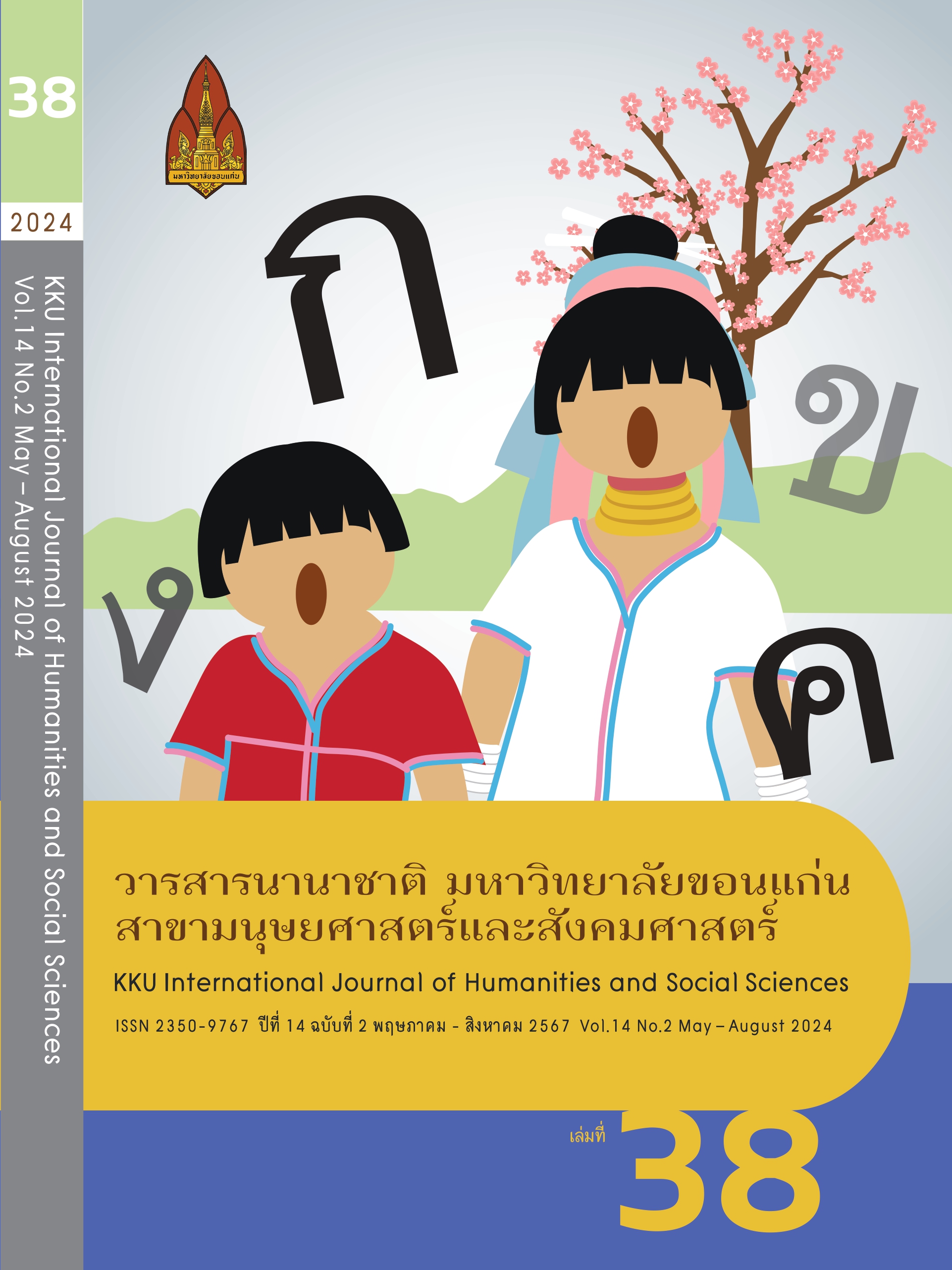The Attitude of Personnel toward the Internal Communication Platforms and Participative Behaviors in Khon Kaen University
Main Article Content
Abstract
This research aimed at examining organizational communication reception, attitudes, participation behaviors, and trends among personnel within an organization. The objectives included studying diverse personal characteristics related to organizational communication reception, investigating the relationship between the reception of organizational communication and the attitudes towards internal communication modes, exploring the links between attitudes towards internal communication modes and participation behaviors, and analyzing the relationship between the attitudes towards internal communication modes and the participation behavior trends among personnel. The study used a quantitative methodology with simple random sampling to collect data via questionnaires from 463 personnel. Data analysis involved univariate analysis and descriptive statistics (percentages, mean values, standard deviations, and minimum-maximum values). Mean values assessed effectiveness based on Quality Assessment (ONESQA) and the Commission on Higher Education (CHE) criteria, aligning with Boonchom Srisawat's (2002) findings. Inferential statistics, including independent T-Tests and One-way ANOVA, were used to test the research hypotheses. Statistical analyses were conducted using SPSS for Windows.
The study found that most respondents at Khon Kaen University were female, aged 38-53 (Generation X), known for resilience and strong work ethics. The next prominent group was aged 23-38 (Generation Y), characterized by a desire for recognition and creativity. About one-fifth were over 53 (Baby Boomers), known for diligence and perseverance. Effective communication must consider these diverse groups.
Personnel primarily received information from internal sources (email, memos, circulars, the university website, and bulletin boards) 1-2 times per day between 8:30 AM and 12:00 PM on workdays. Their main interests were university announcements, personnel promotions, training seminars, annual ceremonies, and research updates.
Personnel exhibited a positive attitude towards horizontal communication among peers, primarily facilitated through email, which supports understanding, convenience, speed, coordination, and relationship-building. Top-down communication from management was viewed favorably when clear policies were communicated via modern channels like the university website.
Regarding bottom-up communication, personnel had a moderately positive attitude, using websites, Facebook, and Line to convey issues and expect responsive advice. They hope their feedback will improve organizational processes. Participation in organizational activities, such as academic conferences, professional development, and cultural preservation, was moderate (1-5 times per year), with a high likelihood of continued participation and recommendations to colleagues.
Research indicated that female personnel showed higher frequencies of internal communication reception via email compared to males. Correlation analysis revealed a positive relationship between email communication reception and favorable attitudes towards horizontal communication.
Overall, these findings highlight the need for aligned communication strategies that consider diverse characteristics and preferences to effectively engage personnel.
Article Details
References
ณัฐดนัย เพชรสุ่ม. (2558). พฤติกรรมและความพึงพอใจต่อการสื่อสารภายในองค์การของพนักงานบริษัท ห้องปฏิบัติการกลาง (ประเทศไทย) จํากัด. การศึกษาอิสระปริญญาวารสารศาสตรมหาบัณฑิต สาขาการจัดการการสื่อสารองค์กร คณะวารสารศาสตร์และสื่อสารมวลชน มหาวิทยาลัยธรรมศาสตร์
บุญชม ศรีสะอาด. (2545). การวิจัยเบื้องต้น. พิมพ์ครั้งที่ 7. กรุงเทพฯ: สุวีริยาสาส์น. ประทุมมา ทาแดง, หญิง โพธิสุวรรณ และ สมพิศ นามเปือย. 2557. ประสิทธิผลของช่องทางการรับสื่อประชาสัมพันธ์คณะทันต แพทยศาสตร์ มหาวิทยาลัยขอนแก่น. วารสารวิจัยสถาบัน มหาวิทยาลัยขอนแก่น, 2(2): 87-92.
วรัญญู ดอนเหนือ, ทองรวี ศิลาน้อย และ ปรเมศวร์ จรัสเมธากุล. 2563. การศึกษาประสิทธิภาพการสื่อสารผ่านช่องทางสื่อของ กองสื่อสารองค์กร มหาวิทยาลัยขอนแก่น. วารสารวิชาการ ปขมท., 8(2): 61-69.
อารี จำปากลาย, กาญจนา ตั้งชลทิพย์ และ สุภาณี ปลื้มเจริญ. (2561). ความอยู่ดีมีสุขในสังคมไทย: ความฝันหรือความจริง. พิมพ์ครั้งที่ 1. นครปฐม: สำนักพิมพ์ประชากรและสังคม.
สถาพร นาวานุเคราะห์, อุดมชัย สุพรรณวงศ์ และ ชุตินันท์ พันธ์จรุง. 2562. การศึกษาประสิทธิภาพการสื่อสารผ่านช่องทางสื่อของ กองสื่อสารองค์กร มหาวิทยาลัยขอนแก่น. วารสารวิชาการ ปขมท., 8(2): 61-69.
สุชาติ ประสิทธิ์รัฐสินธุ์. (2548). เทคนิคการวิเคราะห์ตัวแปรหลายตัวสำหรับการวิจัยทางสังคมศาสตร์และพฤติกรรมศาสตร์ : หลักการ วิธีการและการประยุกต์. พิมพ์ครั้งที่ 5. กรุงเทพฯ: สามลดา.
สุภากรณ์ อานุภาพศรีธาดา. (2558). พฤติกรรมการสื่อสารภายในองค์กรของ สำนักงานคณะกรรมการพิเศษเพื่อประสานงานโครงการอันเนื่องมาจากพระราชดําริ (สำนักงาน กปร.). การศึกษาอิสระปริญญาวารสารศาสตรมหาบัณฑิต สาขาการจัดการการสื่อสารองค์กร คณะวารสารศาสตร์และสื่อสารมวลชน มหาวิทยาลัยธรรมศาสตร์
สมยศ นาวีการ. (2544). การติดต่อสื่อสารขององค์การ. พิมพ์ครั้งที่ 1. กรุงเทพฯ: สํานักพิมพ์บรรณกิจ 1991.
Cronbach, L. J. (1990). Essentials of psychological testing. 5th ed. New York: Harper Collins Publishers.
Yamane, T. (1973). Statistics: An introductory statistic. 2nd ed. New York: Harper & Row.


